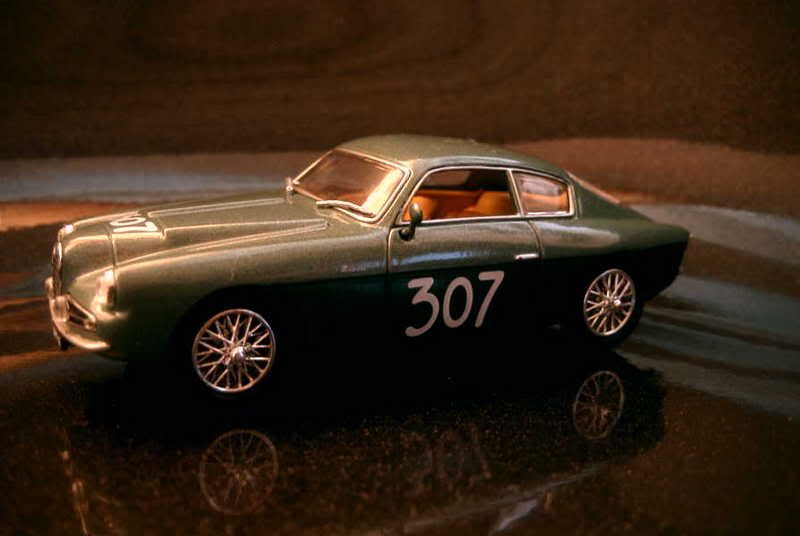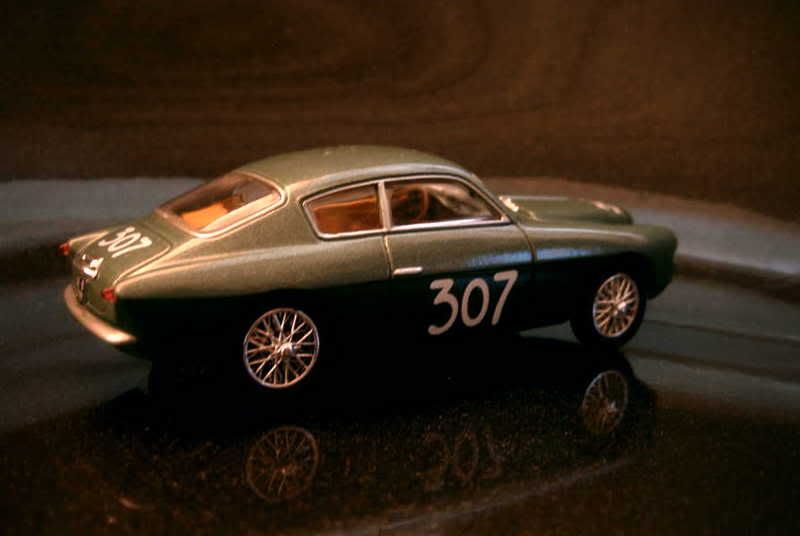A little history
With its 1900 model, Alfa Romeo turned the page of the low-volume, handmade automobiles and entered the era of mass production. Appearing at exactly the right time, the 1900 probably saved Alfa from an otherwise inescapable fate: would they have had such a car to produce, most probably companies such as Hotchkiss or Salmson would still be around today.
The 1900 was designed as a replacement to the pre-war 6C-2500 model. After a prototype was unveiled at the Turin motor show in May 1950, further development was needed and the production model wasn’t introduced to the press before early October. A few days later, the new car was officially launched during the Paris motor show.
A rather modern vehicle, the 1900 featured an elegant though conventional pontoon body. The car had been designed as a monocoque, but despite the lack of a separate chassis many coachbuilders would present special bodies based on this car during its lifetime. A brand new 1.9-litre twin cam four had been created for the 1900. Fitted with alloy cylinder heads, it was rated at 80 bhp, enough to make the new Alfa Romeo, with its 165 kph top speed, a worthy heir to all its pre-war ancestors. Transmission was unsurprisingly to the rear wheels through a 4-speed manual gearbox. Suspension was independent at the front, while a live axle had been fitted at the rear.
Initially available only as a saloon, the 1900 saw several other models appearing from 1951 on. During that year, Alfa Romeo presented a shorter 1900C chassis which was used by Touring to develop a Sprint coupe and by Pininfarina to design a Spyder convertible. Though only these two models were sold through Alfa Romeo dealerships, many other creations were based on the 1900C, usually signed by Zagato, Ghia, Bertone or Boano. More powerful versions were also added, starting with the 100 bhp “TI”, later followed by the 2.0-litre Super and TI Super.
A car bearing the Alfa Romeo name should race, and the 1900 was no exception. Apart from standard saloons and coupes raced by private entrants, the most noteworthy model was the Disco Volante, a Touring design officially named 1900C 52. Juan Manuel Fangio drove a Disco Volante to second place during the 1953 Mille Miglia. If I’m not mistaking that should be the year in which the great Argentinean hid to its mechanics the little problem he had to deal with – when the steering wheel was turned, only one front wheel would move…
Other special 1900s included the BAT prototypes by Bertone, research vehicles designed with best aerodynamics in mind, and their complete contrary, the Matta four-wheel-drive jeep using the engine and a few mechanical parts from the 1900.
Production of the 1900 lasted until 1959, when it was succeeded by the Alfa Romeo 2000.
It has to be mentioned that the 1900 was produced under licence by two other carmakers: the agonizing Imperia in Belgium in 1953 and 1954, and by Kaiser’s Argentinean branch as the IKA Bergantin, the latter being powered by less-noble Willys engines.
About the model
Model: Alfa Romeo 1900 SS Zagato
Year: 1954
Event: 1956 Mille Miglia, driven by Paolo Lena (finished 36th)
Maker: unknown
Scale: 1/43
Distributed by: Fabbri as no.38 of its Alfa Romeo Sport Collection press series
Acquired: new with neither box nor stand (probably a production overrun or quality control reject), in December 2006, in Hong Kong, S.A.R.
Though its wire wheels look a too much plastic-like, this is otherwise a very acceptable model deserving a 12/20.



With its 1900 model, Alfa Romeo turned the page of the low-volume, handmade automobiles and entered the era of mass production. Appearing at exactly the right time, the 1900 probably saved Alfa from an otherwise inescapable fate: would they have had such a car to produce, most probably companies such as Hotchkiss or Salmson would still be around today.
The 1900 was designed as a replacement to the pre-war 6C-2500 model. After a prototype was unveiled at the Turin motor show in May 1950, further development was needed and the production model wasn’t introduced to the press before early October. A few days later, the new car was officially launched during the Paris motor show.
A rather modern vehicle, the 1900 featured an elegant though conventional pontoon body. The car had been designed as a monocoque, but despite the lack of a separate chassis many coachbuilders would present special bodies based on this car during its lifetime. A brand new 1.9-litre twin cam four had been created for the 1900. Fitted with alloy cylinder heads, it was rated at 80 bhp, enough to make the new Alfa Romeo, with its 165 kph top speed, a worthy heir to all its pre-war ancestors. Transmission was unsurprisingly to the rear wheels through a 4-speed manual gearbox. Suspension was independent at the front, while a live axle had been fitted at the rear.
Initially available only as a saloon, the 1900 saw several other models appearing from 1951 on. During that year, Alfa Romeo presented a shorter 1900C chassis which was used by Touring to develop a Sprint coupe and by Pininfarina to design a Spyder convertible. Though only these two models were sold through Alfa Romeo dealerships, many other creations were based on the 1900C, usually signed by Zagato, Ghia, Bertone or Boano. More powerful versions were also added, starting with the 100 bhp “TI”, later followed by the 2.0-litre Super and TI Super.
A car bearing the Alfa Romeo name should race, and the 1900 was no exception. Apart from standard saloons and coupes raced by private entrants, the most noteworthy model was the Disco Volante, a Touring design officially named 1900C 52. Juan Manuel Fangio drove a Disco Volante to second place during the 1953 Mille Miglia. If I’m not mistaking that should be the year in which the great Argentinean hid to its mechanics the little problem he had to deal with – when the steering wheel was turned, only one front wheel would move…
Other special 1900s included the BAT prototypes by Bertone, research vehicles designed with best aerodynamics in mind, and their complete contrary, the Matta four-wheel-drive jeep using the engine and a few mechanical parts from the 1900.
Production of the 1900 lasted until 1959, when it was succeeded by the Alfa Romeo 2000.
It has to be mentioned that the 1900 was produced under licence by two other carmakers: the agonizing Imperia in Belgium in 1953 and 1954, and by Kaiser’s Argentinean branch as the IKA Bergantin, the latter being powered by less-noble Willys engines.
About the model
Model: Alfa Romeo 1900 SS Zagato
Year: 1954
Event: 1956 Mille Miglia, driven by Paolo Lena (finished 36th)
Maker: unknown
Scale: 1/43
Distributed by: Fabbri as no.38 of its Alfa Romeo Sport Collection press series
Acquired: new with neither box nor stand (probably a production overrun or quality control reject), in December 2006, in Hong Kong, S.A.R.
Though its wire wheels look a too much plastic-like, this is otherwise a very acceptable model deserving a 12/20.






2 comments:
Hey are you a professional journalist? This article is very well written, as compared to most other blogs i saw today….
anyhow thanks for the good read!
No I'm not. Thanks anyway for the very kind feedback! Enjoy your stay!
Post a Comment